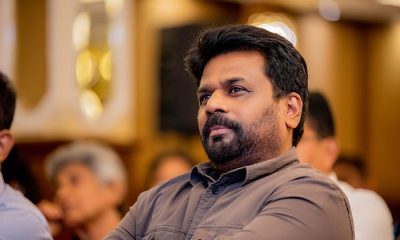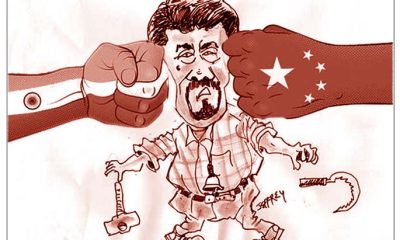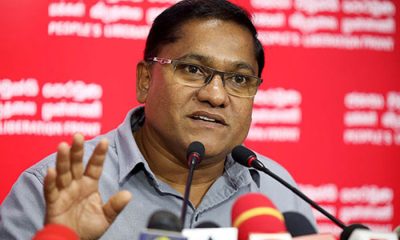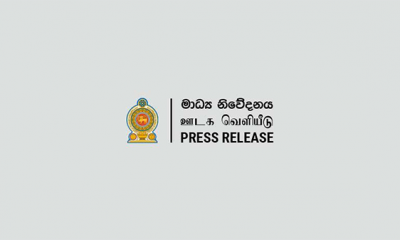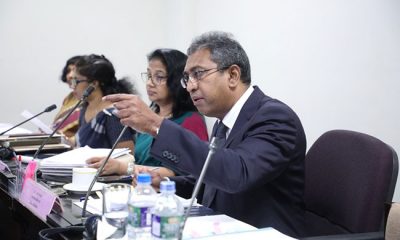Features
AKD’s fixation on assets vs. liabilities:
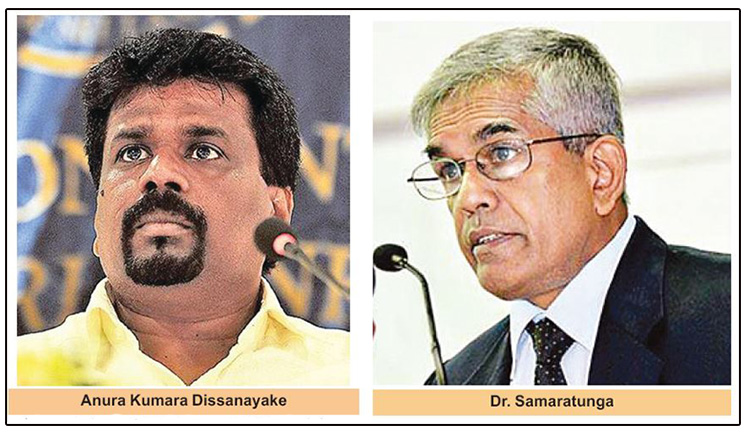
An Open Letter to Dr R. H. S.Samaratunga former Secretary, Ministry of Finance
Dear Dr. Samaratunga,
I am addressing this letter to you because you were the Secretary to the Ministry of Finance when the item ‘non-financial assets’ was added in 2015 to the ‘Statement of Financial Position’ in the Finance Ministry’s annual reports. Up to that time, only financial assets had been accounted for in the Statement of Financial Position.
In normal circumstances, a change as esoteric as that would have gone completely unnoticed by the general public. However in February 2018, the then Auditor General Gamini Wjesinghe stated at a press conference held to introduce his report on ‘Public Debt Management’ that while the Finance Ministry records a total national debt of Rs. 8.8 trillion as at the end of 2016, the assets base is indicated as just Rs. 1.1 trillion. From that point onwards, the JVP started using these figures in political campaigns to bolster their claims of massive corruption on the part of successive governments.
Speaking in Los Angeles this year, Anura Kumara Dissanayake (AKD) stated that various governments had taken project loans amounting to Rs. eight trillion but that there were assets worth only two trillion. (He was obviously using the figures in the Finance Ministry’s 2022 Statement of Financial Position.) On this basis AKD stated that over 75% of the project funds had been stolen and that all the projects had been built with just 25% of the funds borrowed. He repeatedly mentioned this apparent disparity between liabilities and assets even during his recent interview on Derana TV. This has become a fundamental part of the JVPs political campaign in the presidential election.
When the finance ministry first started including non-financial assets in the Statement of Financial Position in 2015 under your watch, the total value of non-financial assets was given as Rs. 21.2 billion. By the time Auditor General Gamini Wijesinghe spoke about this matter in 2018, the value of non-financial assets in the Statement of Financial Position had gone up to just over Rs. one trillion. In the latest available (2022) Statement of Financial Position, the total value of non-financial assets is given as just over Rs. two trillion.
The note on ‘government borrowings’ in the finance ministry’s Statement of Financial Position also seems to have become more detailed during the period after 2015. Even though the 2015 Statement of Financial Position (or those that preceded it) did not indicate ‘foreign project loans’ separately in the breakdown of government borrowings, in the Statement of Financial Position, we begin to see foreign borrowings for projects featuring in the breakdown of government borrowings from 2017 onwards. Thus in the latest available (2022) Statement of Financial Position we see over Rs. 7.6 trillion (which can be rounded off to 8 trillion as AKD has obviously done) listed as foreign loans for projects in the note on government borrowings.
The Rs. two trillion worth of non-financial assets mentioned in the 2022 Statement of Financial Position are not just the assets built with foreign project loans but ALL the non-financial assets of the Republic of Sri Lanka. If the value of any assets built with foreign loans has been included at all under the rubric of non-financial assets in the 2022 Statement of Financial Position, it will be only a miniscule proportion of the total amount mentioned. When AKD realises this, he may start claiming that 99% of the foreign project funds had been stolen and that the all projects had been built with just 1% of the amount borrowed!
We can arrive at an understanding of what is expected by the inclusion of ‘non-financial assets’ in the financial statements of the Ministry of Finance by perusing the IMF’s Government Finance Statistics Manual of 2014. According to the IMF manual, the non-financial assets of a nation state are made up of ‘produced assets’ which include all fixed assets, inventories and valuables, and ‘non-produced assets’ such as land and natural resources. Thus in order to have a proper valuation of the non-financial assets of a nation state, all the land, buildings, streets, highways, lighting systems, bridges, communication networks, canals, and heritage assets, such as Sigiriya, and the Ruwanweliseya, which are assets that ‘a government intends to preserve indefinitely because they have unique historic, cultural, educational, artistic, or architectural significance’ will have to be included under non-financial assets.
King Sri Wickrema Rajasingha’s throne in the museum, all Dutch coins and the paintings at President’s house will have to be included under ‘valuables’ and under natural resources will have to be included items such as the value of the electromagnetic spectrum, the natural resources in the sea within Sri Lanka’s exclusive economic zone, the value of the graphite, phosphate, gem and mineral sands deposits in Sri Lanka etc. Any sensible person will see that the task of having a proper valuation of the non-financial assets of a nation state to be included in the Statement of Financial Position is a task like trying to empty the Beira Lake with a tea cup.
Furthermore, the IMF’s Government Finance Statistics Manual of 2014 stipulates that non-financial assets should be valued at current market prices. If anyone is wondering how heritage assets like the Dalada Maligawa or the Munneswaram Kovil are to be valued at current market prices, the IMF manual has an answer – “When there are no observable prices because the items in question have not been purchased or sold on the market in the recent past, an attempt has to be made to estimate what the prices would be were the assets to be acquired on the market on the date to which the balance sheet relates.”
For officials of the Finance Ministry or qualified valuers to spend time on such an exercise is nothing short of insanity. Furthermore, Sri Lanka is a country where many government entities have not presented their annual reports to Parliament for years. To expect such a country to have the current market prices of the sum total of non-financial assets of the nation stated accurately in the annual Statement of Financial Position is something that is not going to happen in this century or the next.
The compilers of the IMF’s Government Finance Statistics Manual of 2014 knew that what they were trying to promote was a tall order. They observed that “It is recognized that the implementation of the fully integrated GFS (government finance statistics) framework presented in this Manual will take some time”. And further that – “A more difficult step is likely to be the collection of a complete set of information about the stock positions of non-financial assets held at a given time and their valuation at current market prices”. Such admissions can qualify as the understatements of the 21st century.
The head of the National Accounts Division of the OECD observed in 2017 that the measurement of non-financial assets is one of the most problematic areas in national accounts and that only a few countries like Australia and France have a fairly complete set of balance sheets, although their statistics also contain information gaps. Accurately accounting for non-financial assets in the statement of Financial Position is not a tall order only for Sri Lanka but for almost all countries in the world. Nobody living today, in any country will be able to use the item ‘non-financial assets’ in the balance sheets of nation states in any meaningful way in macroeconomic analysis during their lifetimes.
Our Ministry of Finance would have known that this was a ‘mission impossible’ when the item non-financial assets was included in the Statement of Financial Position. Then, why did they embark on an exercise akin to trying to empty the Beira Lake with a tea cup? Did the IMF or some other important international body insist that non-financial assets be included in the financial statements? Or did the pressure come from a local entity like the Auditor General’s Dept.? Either way, why did the finance ministry succumb to such pressure and take on a task that can never be fulfilled and waste time, money and resources in reporting useless data that cannot, and will never be used in any kind of macroeconomic analysis?
The amounts mentioned as the value of ‘non-financial assets’ in Sri Lanka’s Statement of Financial Position are unusable on account of being incomplete. Note 17 in the 2022 Statement of Financial Position has given the breakdown of non-financial assets as follows – buildings, machinery, land, biological assets, intangible assets, work in progress, and leases. The amount stated as the total value of the buildings of the Republic in 2022 is just over Rs. 375 billion. When that is translated into US Dollars at the 2022 exchange rate, the total value of the buildings of the Republic becomes 1.15 billion USD – roughly the amount that the government got as an upfront payment for the lease of the Hambantota Harbour in 2017.
The Finance Ministry may be making valiant efforts to account for all the non-financial assets of the Republic the way a madman would frantically try to empty the Beira Lake with a tea cup, but they are not likely to get anywhere with regard to this matter in this birth or the next. The item ‘non-financial assets’ in the Statement of Financial Position will perpetually be a work in progress serving no useful purpose. Nearly a decade after this item was introduced to the financial statements of the Finance Ministry, only the JVP has found a use – albeit a political one – for this data on non-financial assets produced in the Finance Ministry’s Statement of Financial Position.
When a Statement of Financial Position with a glaringly understated accounting of non-financial assets goes to the Auditor General’s Department which will be full of those from accounting and book-keeping backgrounds, questions will be raised about the lack of assets when compared to liabilities. The Auditor General’s 2018 report on Public Debt Management has stated the obvious in saying that the reason for the lack of non-financial assets in the Finance Ministry’s Statement of Financial Position is due to the failure to correctly identify and account for the assets that should be included under that item.
So long as the Ministry of Finance continues to have non-financial assets as an item in their Statement of Financial Position, the Auditor General’s Department will have no option but to continue to find fault with the Ministry of Finance for failing to ‘identify and account for’ the assets that should be included in the Statement of Financial Position. The people of this country will be able to live with that just as they have learnt to live with the fact that most government owned entities fail to present their annual reports to Parliament on time. What will be more difficult to live with will be how the figures for non-financial assets mentioned in the Finance Ministry’s Statement of Financial Position is understood by some politicians.
Today, AKD states that project loans taken amount to Rs. 8 trillion while the assets built with those loans amount to only Rs. 2 trillion. As I said earlier, when he realizes that the Rs. two trillion in non-financial assets mentioned in the 2022 Statement of Financial Position refers to all the assets of the Republic and not just the assets built with foreign loans, he may start saying that 99% of all foreign project loans had been stolen and that the projects had been built with just 1% of the borrowed funds.
If the result of the presidential election goes the wrong way, some very unpleasant things could happen in a quest to recover the money deemed to have been ‘stolen’ from foreign borrowings for projects. Since the starting point of all this was the inclusion of the item ‘non-financial assets’ in the Finance Ministry’s Statement of Financial Position in 2015, when you, Dr. Samaratunga, held the position of Secretary to the Ministry of Finance, you should come forward and explain matters to the public.
There are thousands of economists, accountants, civil servants, business executives, financial analysts, academics and the like in this country. Yet the only group of people in Sri Lanka who have found some use for the figures on non-financial assets reported in the Finance Ministry’s Statement of Financial Position is the JVP which has a history of doing very unpleasant things on the basis of their understanding of the world. Hence I earnestly request you to explain this issue of non-financial assets reported in the Finance Ministry’s Statement of Financial Position to the public as it is now no longer just an item included in the financial statements of the Finance Ministry but quite literally a matter of life and death for many people.
Yours sincerely
C. A. Chandraprema
Features
The heart-friendly health minister

by Dr Gotabhya Ranasinghe
Senior Consultant Cardiologist
National Hospital Sri Lanka
When we sought a meeting with Hon Dr. Ramesh Pathirana, Minister of Health, he graciously cleared his busy schedule to accommodate us. Renowned for his attentive listening and deep understanding, Minister Pathirana is dedicated to advancing the health sector. His openness and transparency exemplify the qualities of an exemplary politician and minister.
Dr. Palitha Mahipala, the current Health Secretary, demonstrates both commendable enthusiasm and unwavering support. This combination of attributes makes him a highly compatible colleague for the esteemed Minister of Health.
Our discussion centered on a project that has been in the works for the past 30 years, one that no other minister had managed to advance.
Minister Pathirana, however, recognized the project’s significance and its potential to revolutionize care for heart patients.
The project involves the construction of a state-of-the-art facility at the premises of the National Hospital Colombo. The project’s location within the premises of the National Hospital underscores its importance and relevance to the healthcare infrastructure of the nation.
This facility will include a cardiology building and a tertiary care center, equipped with the latest technology to handle and treat all types of heart-related conditions and surgeries.
Securing funding was a major milestone for this initiative. Minister Pathirana successfully obtained approval for a $40 billion loan from the Asian Development Bank. With the funding in place, the foundation stone is scheduled to be laid in September this year, and construction will begin in January 2025.
This project guarantees a consistent and uninterrupted supply of stents and related medications for heart patients. As a result, patients will have timely access to essential medical supplies during their treatment and recovery. By securing these critical resources, the project aims to enhance patient outcomes, minimize treatment delays, and maintain the highest standards of cardiac care.
Upon its fruition, this monumental building will serve as a beacon of hope and healing, symbolizing the unwavering dedication to improving patient outcomes and fostering a healthier society.We anticipate a future marked by significant progress and positive outcomes in Sri Lanka’s cardiovascular treatment landscape within the foreseeable timeframe.
Features
A LOVING TRIBUTE TO JESUIT FR. ALOYSIUS PIERIS ON HIS 90th BIRTHDAY

by Fr. Emmanuel Fernando, OMI
Jesuit Fr. Aloysius Pieris (affectionately called Fr. Aloy) celebrated his 90th birthday on April 9, 2024 and I, as the editor of our Oblate Journal, THE MISSIONARY OBLATE had gone to press by that time. Immediately I decided to publish an article, appreciating the untiring selfless services he continues to offer for inter-Faith dialogue, the renewal of the Catholic Church, his concern for the poor and the suffering Sri Lankan masses and to me, the present writer.
It was in 1988, when I was appointed Director of the Oblate Scholastics at Ampitiya by the then Oblate Provincial Fr. Anselm Silva, that I came to know Fr. Aloy more closely. Knowing well his expertise in matters spiritual, theological, Indological and pastoral, and with the collaborative spirit of my companion-formators, our Oblate Scholastics were sent to Tulana, the Research and Encounter Centre, Kelaniya, of which he is the Founder-Director, for ‘exposure-programmes’ on matters spiritual, biblical, theological and pastoral. Some of these dimensions according to my view and that of my companion-formators, were not available at the National Seminary, Ampitiya.
Ever since that time, our Oblate formators/ accompaniers at the Oblate Scholasticate, Ampitiya , have continued to send our Oblate Scholastics to Tulana Centre for deepening their insights and convictions regarding matters needed to serve the people in today’s context. Fr. Aloy also had tried very enthusiastically with the Oblate team headed by Frs. Oswald Firth and Clement Waidyasekara to begin a Theologate, directed by the Religious Congregations in Sri Lanka, for the contextual formation/ accompaniment of their members. It should very well be a desired goal of the Leaders / Provincials of the Religious Congregations.
Besides being a formator/accompanier at the Oblate Scholasticate, I was entrusted also with the task of editing and publishing our Oblate journal, ‘The Missionary Oblate’. To maintain the quality of the journal I continue to depend on Fr. Aloy for his thought-provoking and stimulating articles on Biblical Spirituality, Biblical Theology and Ecclesiology. I am very grateful to him for his generous assistance. Of late, his writings on renewal of the Church, initiated by Pope St. John XX111 and continued by Pope Francis through the Synodal path, published in our Oblate journal, enable our readers to focus their attention also on the needed renewal in the Catholic Church in Sri Lanka. Fr. Aloy appreciated very much the Synodal path adopted by the Jesuit Pope Francis for the renewal of the Church, rooted very much on prayerful discernment. In my Religious and presbyteral life, Fr.Aloy continues to be my spiritual animator / guide and ongoing formator / acccompanier.
Fr. Aloysius Pieris, BA Hons (Lond), LPh (SHC, India), STL (PFT, Naples), PhD (SLU/VC), ThD (Tilburg), D.Ltt (KU), has been one of the eminent Asian theologians well recognized internationally and one who has lectured and held visiting chairs in many universities both in the West and in the East. Many members of Religious Congregations from Asian countries have benefited from his lectures and guidance in the East Asian Pastoral Institute (EAPI) in Manila, Philippines. He had been a Theologian consulted by the Federation of Asian Bishops’ Conferences for many years. During his professorship at the Gregorian University in Rome, he was called to be a member of a special group of advisers on other religions consulted by Pope Paul VI.
Fr. Aloy is the author of more than 30 books and well over 500 Research Papers. Some of his books and articles have been translated and published in several countries. Among those books, one can find the following: 1) The Genesis of an Asian Theology of Liberation (An Autobiographical Excursus on the Art of Theologising in Asia, 2) An Asian Theology of Liberation, 3) Providential Timeliness of Vatican 11 (a long-overdue halt to a scandalous millennium, 4) Give Vatican 11 a chance, 5) Leadership in the Church, 6) Relishing our faith in working for justice (Themes for study and discussion), 7) A Message meant mainly, not exclusively for Jesuits (Background information necessary for helping Francis renew the Church), 8) Lent in Lanka (Reflections and Resolutions, 9) Love meets wisdom (A Christian Experience of Buddhism, 10) Fire and Water 11) God’s Reign for God’s poor, 12) Our Unhiddden Agenda (How we Jesuits work, pray and form our men). He is also the Editor of two journals, Vagdevi, Journal of Religious Reflection and Dialogue, New Series.
Fr. Aloy has a BA in Pali and Sanskrit from the University of London and a Ph.D in Buddhist Philosophy from the University of Sri Lankan, Vidyodaya Campus. On Nov. 23, 2019, he was awarded the prestigious honorary Doctorate of Literature (D.Litt) by the Chancellor of the University of Kelaniya, the Most Venerable Welamitiyawe Dharmakirthi Sri Kusala Dhamma Thera.
Fr. Aloy continues to be a promoter of Gospel values and virtues. Justice as a constitutive dimension of love and social concern for the downtrodden masses are very much noted in his life and work. He had very much appreciated the commitment of the late Fr. Joseph (Joe) Fernando, the National Director of the Social and Economic Centre (SEDEC) for the poor.
In Sri Lanka, a few religious Congregations – the Good Shepherd Sisters, the Christian Brothers, the Marist Brothers and the Oblates – have invited him to animate their members especially during their Provincial Congresses, Chapters and International Conferences. The mainline Christian Churches also have sought his advice and followed his seminars. I, for one, regret very much, that the Sri Lankan authorities of the Catholic Church –today’s Hierarchy—- have not sought Fr.
Aloy’s expertise for the renewal of the Catholic Church in Sri Lanka and thus have not benefited from the immense store of wisdom and insight that he can offer to our local Church while the Sri Lankan bishops who governed the Catholic church in the immediate aftermath of the Second Vatican Council (Edmund Fernando OMI, Anthony de Saram, Leo Nanayakkara OSB, Frank Marcus Fernando, Paul Perera,) visited him and consulted him on many matters. Among the Tamil Bishops, Bishop Rayappu Joseph was keeping close contact with him and Bishop J. Deogupillai hosted him and his team visiting him after the horrible Black July massacre of Tamils.
Features
A fairy tale, success or debacle

Sri Lanka-Singapore Free Trade Agreement
By Gomi Senadhira
senadhiragomi@gmail.com
“You might tell fairy tales, but the progress of a country cannot be achieved through such narratives. A country cannot be developed by making false promises. The country moved backward because of the electoral promises made by political parties throughout time. We have witnessed that the ultimate result of this is the country becoming bankrupt. Unfortunately, many segments of the population have not come to realize this yet.” – President Ranil Wickremesinghe, 2024 Budget speech
Any Sri Lankan would agree with the above words of President Wickremesinghe on the false promises our politicians and officials make and the fairy tales they narrate which bankrupted this country. So, to understand this, let’s look at one such fairy tale with lots of false promises; Ranil Wickremesinghe’s greatest achievement in the area of international trade and investment promotion during the Yahapalana period, Sri Lanka-Singapore Free Trade Agreement (SLSFTA).
It is appropriate and timely to do it now as Finance Minister Wickremesinghe has just presented to parliament a bill on the National Policy on Economic Transformation which includes the establishment of an Office for International Trade and the Sri Lanka Institute of Economics and International Trade.
Was SLSFTA a “Cleverly negotiated Free Trade Agreement” as stated by the (former) Minister of Development Strategies and International Trade Malik Samarawickrama during the Parliamentary Debate on the SLSFTA in July 2018, or a colossal blunder covered up with lies, false promises, and fairy tales? After SLSFTA was signed there were a number of fairy tales published on this agreement by the Ministry of Development Strategies and International, Institute of Policy Studies, and others.
However, for this article, I would like to limit my comments to the speech by Minister Samarawickrama during the Parliamentary Debate, and the two most important areas in the agreement which were covered up with lies, fairy tales, and false promises, namely: revenue loss for Sri Lanka and Investment from Singapore. On the other important area, “Waste products dumping” I do not want to comment here as I have written extensively on the issue.
1. The revenue loss
During the Parliamentary Debate in July 2018, Minister Samarawickrama stated “…. let me reiterate that this FTA with Singapore has been very cleverly negotiated by us…. The liberalisation programme under this FTA has been carefully designed to have the least impact on domestic industry and revenue collection. We have included all revenue sensitive items in the negative list of items which will not be subject to removal of tariff. Therefore, 97.8% revenue from Customs duty is protected. Our tariff liberalisation will take place over a period of 12-15 years! In fact, the revenue earned through tariffs on goods imported from Singapore last year was Rs. 35 billion.
The revenue loss for over the next 15 years due to the FTA is only Rs. 733 million– which when annualised, on average, is just Rs. 51 million. That is just 0.14% per year! So anyone who claims the Singapore FTA causes revenue loss to the Government cannot do basic arithmetic! Mr. Speaker, in conclusion, I call on my fellow members of this House – don’t mislead the public with baseless criticism that is not grounded in facts. Don’t look at petty politics and use these issues for your own political survival.”
I was surprised to read the minister’s speech because an article published in January 2018 in “The Straits Times“, based on information released by the Singaporean Negotiators stated, “…. With the FTA, tariff savings for Singapore exports are estimated to hit $10 million annually“.
As the annual tariff savings (that is the revenue loss for Sri Lanka) calculated by the Singaporean Negotiators, Singaporean $ 10 million (Sri Lankan rupees 1,200 million in 2018) was way above the rupees’ 733 million revenue loss for 15 years estimated by the Sri Lankan negotiators, it was clear to any observer that one of the parties to the agreement had not done the basic arithmetic!
Six years later, according to a report published by “The Morning” newspaper, speaking at the Committee on Public Finance (COPF) on 7th May 2024, Mr Samarawickrama’s chief trade negotiator K.J. Weerasinghehad had admitted “…. that forecasted revenue loss for the Government of Sri Lanka through the Singapore FTA is Rs. 450 million in 2023 and Rs. 1.3 billion in 2024.”
If these numbers are correct, as tariff liberalisation under the SLSFTA has just started, we will pass Rs 2 billion very soon. Then, the question is how Sri Lanka’s trade negotiators made such a colossal blunder. Didn’t they do their basic arithmetic? If they didn’t know how to do basic arithmetic they should have at least done their basic readings. For example, the headline of the article published in The Straits Times in January 2018 was “Singapore, Sri Lanka sign FTA, annual savings of $10m expected”.
Anyway, as Sri Lanka’s chief negotiator reiterated at the COPF meeting that “…. since 99% of the tariffs in Singapore have zero rates of duty, Sri Lanka has agreed on 80% tariff liberalisation over a period of 15 years while expecting Singapore investments to address the imbalance in trade,” let’s turn towards investment.
Investment from Singapore
In July 2018, speaking during the Parliamentary Debate on the FTA this is what Minister Malik Samarawickrama stated on investment from Singapore, “Already, thanks to this FTA, in just the past two-and-a-half months since the agreement came into effect we have received a proposal from Singapore for investment amounting to $ 14.8 billion in an oil refinery for export of petroleum products. In addition, we have proposals for a steel manufacturing plant for exports ($ 1 billion investment), flour milling plant ($ 50 million), sugar refinery ($ 200 million). This adds up to more than $ 16.05 billion in the pipeline on these projects alone.
And all of these projects will create thousands of more jobs for our people. In principle approval has already been granted by the BOI and the investors are awaiting the release of land the environmental approvals to commence the project.
I request the Opposition and those with vested interests to change their narrow-minded thinking and join us to develop our country. We must always look at what is best for the whole community, not just the few who may oppose. We owe it to our people to courageously take decisions that will change their lives for the better.”
According to the media report I quoted earlier, speaking at the Committee on Public Finance (COPF) Chief Negotiator Weerasinghe has admitted that Sri Lanka was not happy with overall Singapore investments that have come in the past few years in return for the trade liberalisation under the Singapore-Sri Lanka Free Trade Agreement. He has added that between 2021 and 2023 the total investment from Singapore had been around $162 million!
What happened to those projects worth $16 billion negotiated, thanks to the SLSFTA, in just the two-and-a-half months after the agreement came into effect and approved by the BOI? I do not know about the steel manufacturing plant for exports ($ 1 billion investment), flour milling plant ($ 50 million) and sugar refinery ($ 200 million).
However, story of the multibillion-dollar investment in the Petroleum Refinery unfolded in a manner that would qualify it as the best fairy tale with false promises presented by our politicians and the officials, prior to 2019 elections.
Though many Sri Lankans got to know, through the media which repeatedly highlighted a plethora of issues surrounding the project and the questionable credentials of the Singaporean investor, the construction work on the Mirrijiwela Oil Refinery along with the cement factory began on the24th of March 2019 with a bang and Minister Ranil Wickremesinghe and his ministers along with the foreign and local dignitaries laid the foundation stones.
That was few months before the 2019 Presidential elections. Inaugurating the construction work Prime Minister Ranil Wickremesinghe said the projects will create thousands of job opportunities in the area and surrounding districts.
The oil refinery, which was to be built over 200 acres of land, with the capacity to refine 200,000 barrels of crude oil per day, was to generate US$7 billion of exports and create 1,500 direct and 3,000 indirect jobs. The construction of the refinery was to be completed in 44 months. Four years later, in August 2023 the Cabinet of Ministers approved the proposal presented by President Ranil Wickremesinghe to cancel the agreement with the investors of the refinery as the project has not been implemented! Can they explain to the country how much money was wasted to produce that fairy tale?
It is obvious that the President, ministers, and officials had made huge blunders and had deliberately misled the public and the parliament on the revenue loss and potential investment from SLSFTA with fairy tales and false promises.
As the president himself said, a country cannot be developed by making false promises or with fairy tales and these false promises and fairy tales had bankrupted the country. “Unfortunately, many segments of the population have not come to realize this yet”.
(The writer, a specialist and an activist on trade and development issues . )


